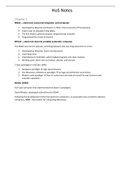Samenvatting
History of Science (XB_0076) Summary Notes (2021/2022)
- Instelling
- Vrije Universiteit Amsterdam (VU)
I have summerized the mandatory chapters which were: 1, 2, 14, 15. The other two chapters that were summerized: 6 and 12 are a natural continuation of each other. Obtained exam score: 9
[Meer zien]




